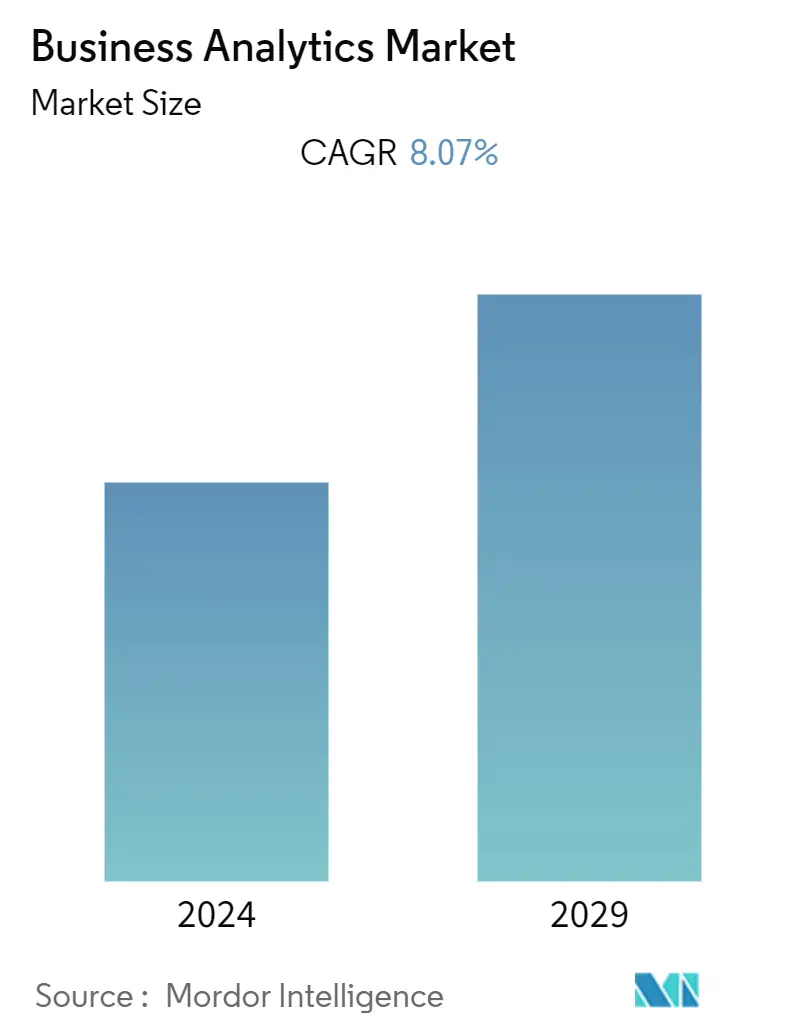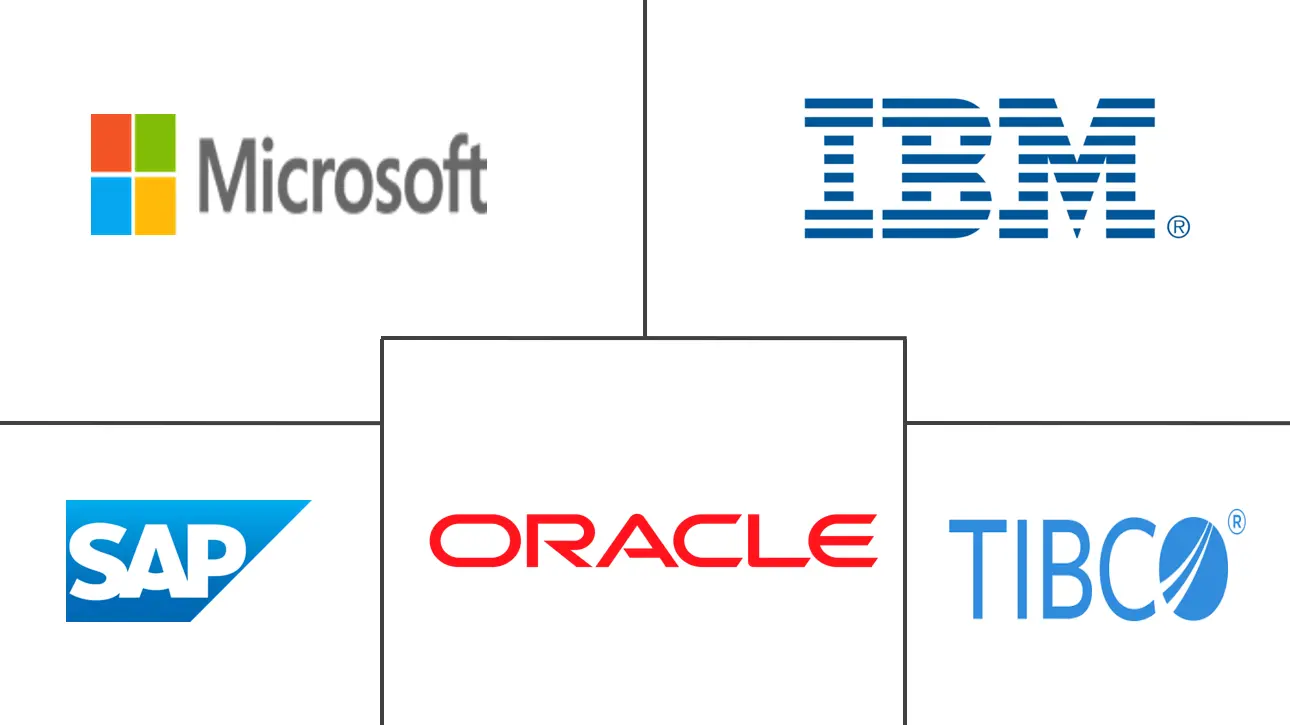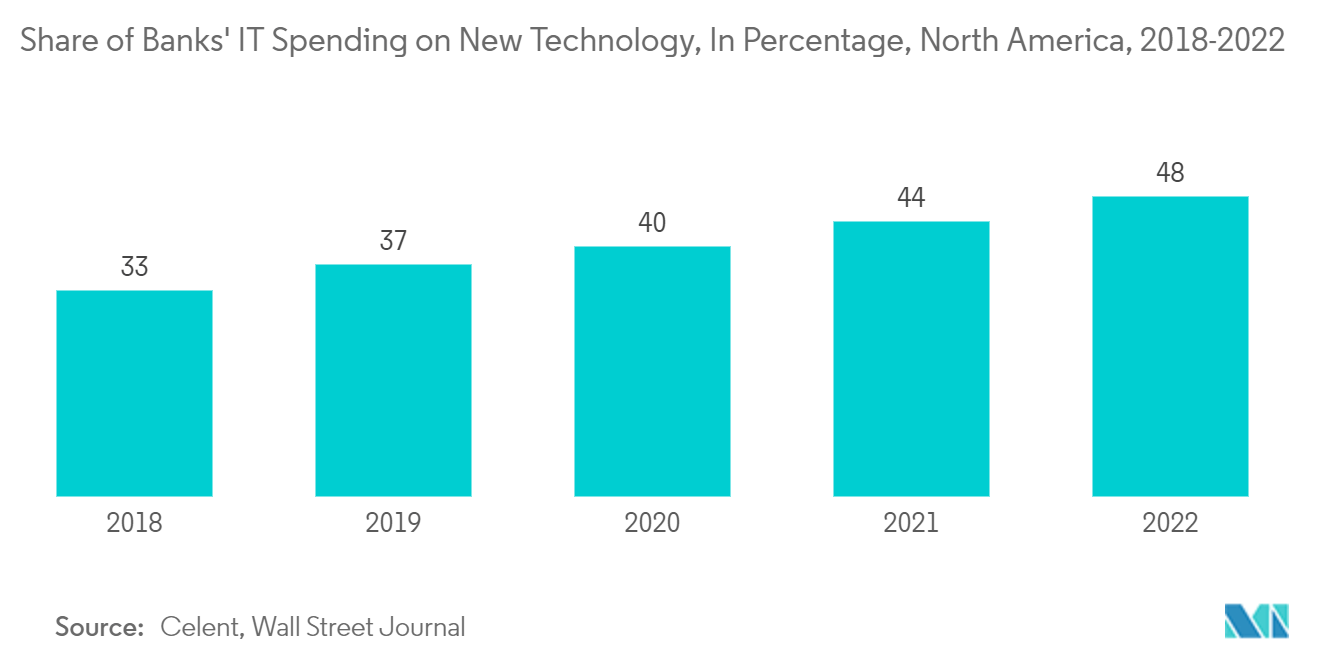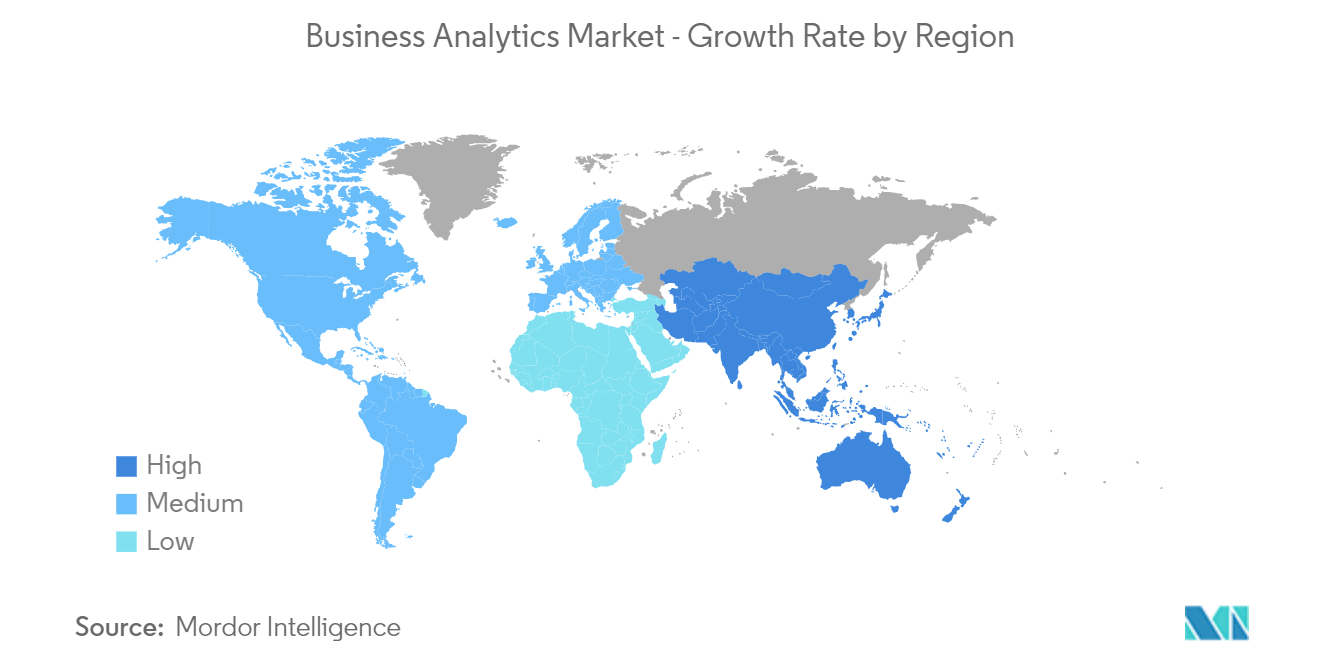Business Analytics Market Size

| Study Period | 2019 - 2029 |
| Base Year For Estimation | 2023 |
| CAGR (2024 - 2029) | 8.07 % |
| Fastest Growing Market | Asia Pacific |
| Largest Market | North America |
| Market Concentration | Low |
Major Players
*Disclaimer: Major Players sorted in no particular order |
Business Analytics Market Analysis
The Business Analytics Market is expected to register a CAGR of 8.07% during the forecast period.
- The business analytics market is primarily driven by the increasing digitalization across end-user industries and the need to improve their businesses with a better understanding of the customers. In addition, market vendors' integration of advanced technologies in business analytics solutions is expected to drive the market in the coming years.
- The business analytics market is evolving quickly. Increasingly, the emphasis is on real-time Business Intelligence (BI) to enable faster decision-making and on Data Visualization, which enables data patterns to be seen more clearly. Additionally, demand for more efficient business analytics solutions is anticipated to be driven by increasing usage among various end users in the upcoming years.
- Traditionally, strategic decisions in many organizations were powered by business analytics that relied on big, centralized-managed data servers or warehouses. However, things have changed recently, and business analysts are pulling data from dozens of heterogeneous data sources.
- In addition, visualization and explorative data analysis for the business user have been evolving into one of the most critical trends in the business analytics market. Various end-user industries also leverage business analytics' power to make strategic business decisions. While business analytics solution helps in supply chain management, inventory management, measuring the performance of targets, and risk mitigation plans in manufacturing, it is extended to include fraud detection and defense.
- Further, the vendors are introducing innovative business analytics solutions by integrating advanced technologies for better data storage facilities and visualization. For instance, modern Machine Language (ML) - powered business analytics platforms offer improved data visibility and comprehension. Furthermore, the proliferation of data has enabled startups to compete successfully with established blue-chip firms by building customized and superior analytics offerings.
- The COVID-19 pandemic led to a boom in digital transformation, such as adopting cloud solutions, Artificial Intelligence (AI), and ML across various industries. The outbreak accelerated many companies' use of advanced business analytics and AI. These strategies helped engage customers through digital channels, manage fragile and complex supply chains, and support workers by disrupting their work and lives. The demand for business analytics solutions exceeded pre-COVID-19 and is expected to grow in the coming years.
Business Analytics Market Trends
BFSI is Expected to Hold Major Share
- Technology is transforming the banking and finance industry. With the rising usage of the internet and the proliferation of mobile devices and apps, today's financial institutions face mounting competition, changing client demands, and strict control and risk management in a highly dynamic market. In addition, the growing digitalization and proliferation of digital payments are driving the need for business analytics in the BFSI industry.
- Further, at the same time, technology has given rise to powerful business analytics tools. The banking and finance industry can use business analytics tools to leverage customer data for insights that can lead to more innovative and efficient management practices and better business decisions. Banking and finance institutions use business analytics solutions to drive profitability, reduce risk, and create a competitive advantage.
- Furthermore, the advent and application of business analytics have helped the banking and finance industry optimize processes and streamline operations, thus improving efficiency and competitiveness. Many banks and financial institutions worldwide are working on improving their business analytics, mainly to give them an edge against the competition or to predict emerging trends that can affect their businesses.
- Moreover, Banking, Financial Services, and Insurance (BFSI) companies are leveraging business analytics solutions to acquire more customers. For instance, with the increasing focus on retail customers, Yes Bank is leveraging data to understand customer behavior. Hence, based on a certain forecasting model, it might provide the ideal mix of products. The bank has already diversified into the retail segment and is now harnessing data analytics to develop models that help understand customer behavior. The bank has built a war chest of about INR 120-150 crore for its data strategy up to 2022-23 and plans to hire data scientists and experts who will be part of the company's TechTONic group, which has 100 in-house experts.
- Moreover, the BFSIs across the world have started adopting new and advanced technologies, thus further opening new opportunities for adopting business analytics solutions in the BFSI industry. For instance, according to the data from Celent and Wall Street Journal, the share of banks' IT spending on new technology in North America is expected to increase from 30% in 2017 to 48% in the current year.

North America is Expected to Hold the Major Share
- The region is home to some of the most prominent market vendors, such as Microsoft, Oracle, and Salesforce.com. These players' continuous product innovations and enhanced product business analytics are finding significant applications in various end-user industries across the region.
- Further, new and emerging players are also competing with giant business analytics players by offering innovative solutions and attracting significant investments in the business analytics market, thus driving the market. For instance, in October 2022, Tellius, a leading AI-driven decision intelligence platform, announced a USD 16 million Series B funding round led by Baird Capital. The latest funding will likely be used to enhance Tellius' decision intelligence platform, expand the company's go-to-market capabilities, and support talent acquisition across sales, marketing, and product engineering functions.
- Moreover, the region is an early adopter of advanced technologies, helping market vendors offer customized and advanced technology-enabled business analytics solutions for consumers. In addition, the region is witnessing high adoption of the cloud across organizations, thus enabling the proper implementation of business analytics.
- Further, accelerated digitalization and early adoption of advanced analytics and cloud computing have emerged as one of the most essential and crucial technologies to gain competitive advantage. As a result, technology leaders across the region are increasingly scaling their enterprises' data and business analytics strategies with the help of cutting-edge cloud services and tools. Such instances are expected to drive the region's demand for business analytics solutions.

Business Analytics Industry Overview
The business analytics market is highly fragmented due to the presence of many small and medium-sized companies competing with each other and large enterprises. Technological advancements in the market are also bringing sustainable competitive advantage to companies, and the market is witnessing multiple partnerships and mergers. Some key players in the market include IBM, Microsoft, and Oracle, among others.
- September 2023: Oracle has announced a next-generation data, analytics, and AI platform to help Oracle Fusion Cloud Applications customers achieve better business outcomes by combining data-driven insights with intelligent decisions and actions. The Fusion Data Intelligence Platform is an evolution of the Oracle Fusion Analytics Warehouse product, which will deliver business data-as-a-service with automated data pipelines, 360-degree data models for critical business entities, rich interactive analytics, AI/ML models, and intelligent applications.
- August 2023: Global retail specialists Smollan formalized an international reseller and implementation partnership agreement with next-generation decision and business intelligence (BI) software provider Pyramid Analytics. The deal will see Smollan, via its data and technology business, DataOrbis, expanding its current service offering to include the ability to both sell Pyramid Analytics licenses and implement Pyramid Analytics software.
Business Analytics Market Leaders
-
Oracle Corporation
-
IBM Corporation
-
SAP SE
-
Microsoft Corporation
-
Tibco Software Inc.
*Disclaimer: Major Players sorted in no particular order

Business Analytics Market News
- June 2023: MicroStrategy Incorporated, the independent publicly traded analytics and business intelligence firm, has started a new multi-year partnership with Microsoft that will extend the availability of MicroStrategy’s products powered by Microsoft Azure. The collaboration will incorporate MicroStrategy’s advanced analytics abilities with Azure OpenAI Service to help businesses harness the full potential of their data.
- May 2023: Rackspace US Inc. announced Object Storage, enabling organizations to store and utilize large pools of unstructured data securely. Rackspace Object Storage saves substantial costs by eliminating data egress, retrieval, and transaction charges. In many cases, the Rackspace Object Storage solution can save more than 80% over hyper-scale cloud storage options. For multi-cloud customers operating modern S3-enabled applications, this is a new paradigm that facilitates better performance and lower costs, even as data-intensive applications continue to drive up the need for storage.
Business Analytics Market Report - Table of Contents
1. INTRODUCTION
- 1.1 Study Assumptions and Market Definition
- 1.2 Scope of the Study
2. RESEARCH METHODOLOGY
3. EXECUTIVE SUMMARY
4. MARKET DYNAMICS
- 4.1 Market Overview
-
4.2 Industry Attractiveness - Porter's Five Forces Analysis
- 4.2.1 Bargaining Power of Suppliers
- 4.2.2 Bargaining Power of Consumers
- 4.2.3 Threat of New Entrants
- 4.2.4 Threat of Substitute Products
- 4.2.5 Intensity of Competitive Rivalry
- 4.3 Industry Value Chain Analysis
- 4.4 Assessment of the Impact Of COVID-19 on the Industry
5. MARKET DYNAMICS
-
5.1 Market Drivers
- 5.1.1 Increasing Volumes of Data and Cloud Deployment
- 5.1.2 Business Analytics/Intelligence Providers' Partnerships with Companies from Diversified Businesses to Leverage Analytics Capabilities
-
5.2 Market Challenges
- 5.2.1 High Investment Costs and Significant Reliance on Traditional Processes
6. MARKET SEGMENTATION
-
6.1 By Deployment
- 6.1.1 On-premise
- 6.1.2 Cloud-based
- 6.1.3 Hybrid
-
6.2 By End-user Industry
- 6.2.1 Banking, Financial Services, and Insurance
- 6.2.2 Healthcare
- 6.2.3 Manufacturing
- 6.2.4 Retail
- 6.2.5 Telecom and IT
- 6.2.6 Other End-user Industries
-
6.3 Geography
- 6.3.1 North America
- 6.3.2 Europe
- 6.3.3 Asia-Pacific
- 6.3.4 Latin America
- 6.3.5 Middle East and Africa
7. COMPETITIVE LANDSCAPE
-
7.1 Company Profiles
- 7.1.1 Oracle Corporation
- 7.1.2 IBM Corporation
- 7.1.3 SAP SE
- 7.1.4 Microsoft Corporation
- 7.1.5 Tibco Software, Inc.
- 7.1.6 SAS Institute, Inc.
- 7.1.7 Infor, Inc.
- 7.1.8 Microstrategy Incorporated
- 7.1.9 QLIK Technologies, Inc.
- 7.1.10 Salesforce.com Inc. (Tableau Software Inc.)
- *List Not Exhaustive
8. INVESTMENT ANALYSIS
9. FUTURE OF THE MARKET
** Subject To AvailablityBusiness Analytics Industry Segmentation
Business analytics refers to the technologies, practices, and skills for continual step-by-step exploration and investigation of the past performance of the businesses to gain various insights and drive business strategy and planning accordingly. Companies use business analytics software for query reporting and analysis tools, advanced and predictive analytics, location intelligence, content analytics, data warehousing platforms, and enterprise performance management.
The business analytics market is segmented by Deployment (Cloud, On-premise, and Hybrid), End-user Industry (BFSI, Healthcare, Manufacturing, Retail, IT, and Telecom), and Geography (North America, Europe, Asia-Pacific, Latin America, and Middle East and Africa). The market sizes and forecasts are provided in terms of value in USD for all the above segments.
| By Deployment | On-premise |
| Cloud-based | |
| Hybrid | |
| By End-user Industry | Banking, Financial Services, and Insurance |
| Healthcare | |
| Manufacturing | |
| Retail | |
| Telecom and IT | |
| Other End-user Industries | |
| Geography | North America |
| Europe | |
| Asia-Pacific | |
| Latin America | |
| Middle East and Africa |
Business Analytics Market Research FAQs
What is the current Business Analytics Market size?
The Business Analytics Market is projected to register a CAGR of 8.07% during the forecast period (2024-2029)
Who are the key players in Business Analytics Market?
Oracle Corporation, IBM Corporation, SAP SE, Microsoft Corporation and Tibco Software Inc. are the major companies operating in the Business Analytics Market.
Which is the fastest growing region in Business Analytics Market?
Asia Pacific is estimated to grow at the highest CAGR over the forecast period (2024-2029).
Which region has the biggest share in Business Analytics Market?
In 2024, the North America accounts for the largest market share in Business Analytics Market.
What years does this Business Analytics Market cover?
The report covers the Business Analytics Market historical market size for years: 2019, 2020, 2021, 2022 and 2023. The report also forecasts the Business Analytics Market size for years: 2024, 2025, 2026, 2027, 2028 and 2029.
What are the key factors driving the Business Analytics Market?
Key factors driving the Business Analytics Market are: a) Include the growing need for data-driven decision-making b) Advancements in analytics c) Business intelligence tools d) Increasing volume of big data
Business Analytics Industry Report
The business analytics market is experiencing rapid growth, driven by increased adoption of analytics software to improve decision-making and gain a competitive edge. This expansion is further propelled by a shift towards cloud-based solutions, especially among SMEs, for their affordability and scalability. The integration of advanced technologies like AI, machine learning, and edge computing into analytics tools is enhancing data processing efficiency and insight generation. Current trends emphasize real-time data analysis and the significance of data visualization for better understanding. The market, categorized by deployment mode, industry verticals, and applications, is witnessing significant growth in sectors such as BFSI, healthcare, retail, and IT & telecom, which depend on data-driven strategies. Business analytics tools are crucial for process optimization, boosting customer satisfaction, and increasing profitability across various industries. As companies navigate the complexities of the digital landscape, the demand for sophisticated business analytics solutions is surging, indicating a promising future for market growth and innovation. For in-depth analysis, Mordor Intelligence™ offers comprehensive reports on market dynamics, including size, share, growth rates, and forecasts, available as a free PDF download.



